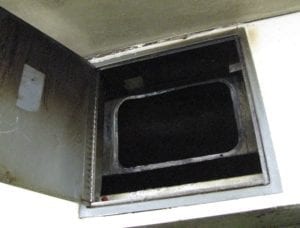Restaurants are relatively frequent victims of accidental fires. Each year, nearly 1 in 100 eating and drinking establishments experiences a fire loss and 57 percent of those fires are caused by cooking equipment (see http://www.nfpa.org/~/media/files/research/nfpa-reports/occupancies/oseating.pdf?la=en). However, the primary factor in determining fire extent and fire damage is often the status of the exhaust system – how well it was designed and installed, and how clean it has been kept.
NFPA 96 “Standard for Ventilation Control and Fire Protection of Commercial Cooking Operations” (http://www.nfpa.org/codes-and-standards/all-codes-and-standards/list-of-codes-and-standards?mode=code&code=96) enumerates dozens of design and maintenance requirements whose intent are to reduce the likelihood of fire initiation and reduce the extent and magnitude of fire damage.
Grease (from cooking operations) is a combustible semi-solid and will accumulate on exhaust system surfaces, even if a well-designed hood and grease removal apparatus is in place. Exhaust duct cleaning is required by NFPA 96 at a frequency that depends on cooking volume. Also, a new standard has been published by the International Kitchen Exhaust Cleaning Association (ANSI/IKECA C-10 “Standard for Cleaning of Commercial Kitchen Exhaust Systems”, see http://www.ikeca.org/news/ansiikeca-c-10-standard) that focuses on inspections, cleaning technologies, and client reporting. Together, these standards provide an authoritative framework for avoiding fires, and for minimizing damage if one should occur accidentally.
One of the requirements in NFPA 96 is “Cooking equipment shall not be operated while its fire‐extinguishing system or exhaust system is nonoperational or otherwise impaired.” Impairment of the exhaust system can arise from any of several maintenance lapses or installation defects (e.g., exhaust fan failure, plugging of exhaust system passageways by accumulated grease, and breaches in the exhaust ductwork where air can infiltrate).
This author investigated a very large fire loss that originated in the basement kitchen of a 10-story hotel, and exhaust system impairment was a major factor. Through interviews, inspections, and analyses, the investigation team discovered the following:
• The kitchen staff had complained of smokiness and uncomfortably high temperatures in the cooking area a few weeks before the fire.
• The fan was determined to be working properly.
• The grease extraction system (type: “water wash”) was heavily laden with grease, and likely had never been serviced by the hood manufacturer since it was installed nearly 20 years prior to the fire. (NFPA 96 requires the owner to engage a trained and certified technician for mechanical system maintenance. This requirement typically excludes the cleaning contractor.)
• The cleaning contractor couldn’t access the internals of the water wash system and several other duct spaces, so they only cleaned the accessible areas of the exhaust system.
• The cleaning contractor was tasked by restaurant management to perform a special cleaning about a week before the fire, ostensibly to find and remove the grease obstruction. Upon arrival, the contractor found one cleanout hatch wide open, and one-half of the two-piece hatch cover assembly missing. Per his custom, he only cleaned accessible areas, and tried to close the cleanout opening with the compromised hatch cover. He reported the missing hatch cover piece to management but was unaware of the major grease accumulation that remained inside the water-wash hood.
• After the fire, at one of the evidence inspections, the investigation team discovered the second half of the hatch cover assembly inside the water-wash hood, directly below the cleanout port where it should have been installed.
 Based on these facts, this author concluded that on the day of the fire (and probably each of the other days since the special cleaning had been performed one week before), the cooking staff had removed the remaining half-cover of the cleanout in order to improve their working conditions in the kitchen. We reached this conclusion in spite of the fact that none of the chefs admitted doing so.
Based on these facts, this author concluded that on the day of the fire (and probably each of the other days since the special cleaning had been performed one week before), the cooking staff had removed the remaining half-cover of the cleanout in order to improve their working conditions in the kitchen. We reached this conclusion in spite of the fact that none of the chefs admitted doing so.
We developed a numerical model to determine how badly the open cleanout port would “impair” the exhaust system, and estimated that with the cleanout port wide open, the flow through the water-wash hood would drop by almost 40% and the flow into the open cleanout port would exceed the hood flow by more than 25%. This would have had the desired effect of cooling the staff’s working environment, while simultaneously compromising the effectiveness of the grease removal device and permitting grease to enter the exhaust duct unabated.
Most importantly, the burn patterns (and some witness statements) indicated the fire actually originated in the duct near the open cleanout port (i.e., downstream of the water-wash hood) and the most likely cause of ignition was a cooking ember that was sucked into the opening and landed on accumulated grease, igniting it.
The primary lessons from this incident were: (a) the cleaning contractor should have explicitly informed the restaurant that they were unable to clean the water wash hood internals; (b) the restaurant shouldn’t have expected the cleaning contractor to maintain and clean the water-wash hood, a complicated piece of machinery that they weren’t trained to service; (c) the cooking staff shouldn’t have compromised the exhaust system by opening the cleanout port, because doing so permitted the fuel (extra grease) and the ignition source (the ember) to meet in that location and initiate the fire.